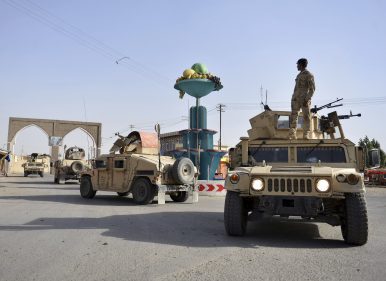By Ankit Panda
 Ghazni, Afghanistan’s twelfth largest city with a population of more than 150,000, is in crisis. On Friday, heavily armed Taliban fighters launched a major assault, reminiscent of previous assaults on major Afghan cities, including Kunduz in 2015 and Lashkar Gah. Ghazni, while smaller than both those cities population-wise, isn’t peripheral—far from it. It sits on Highway 1, the Afghan national ring road, just about 150 kilometers from the capital city of Kabul, on the way to Kandahar, Afghanistan’s second-largest city. This month’s siege underlines just how precarious the Afghan government’s control of even the country’s major population nodes has become.
Ghazni, Afghanistan’s twelfth largest city with a population of more than 150,000, is in crisis. On Friday, heavily armed Taliban fighters launched a major assault, reminiscent of previous assaults on major Afghan cities, including Kunduz in 2015 and Lashkar Gah. Ghazni, while smaller than both those cities population-wise, isn’t peripheral—far from it. It sits on Highway 1, the Afghan national ring road, just about 150 kilometers from the capital city of Kabul, on the way to Kandahar, Afghanistan’s second-largest city. This month’s siege underlines just how precarious the Afghan government’s control of even the country’s major population nodes has become.
The damage done in the ongoing siege is likely still unaccounted for completely. The Afghan Ministry of Defense has already indicated that more than 100—possibly even more than 200—government-affiliated forces have been killed. This is a sum including local police officers and Afghan National Army troops. In addition to government forces, more than 30 civilians appear to have been killed in the crossfire.
On Monday, however, the Afghan government appeared eager to signal that all was well and that the Taliban siege had been quelled, following a major counter-offensive by government forces. “Today, additional troops have been sent to Ghazni City to clear the city from insurgents and maintain the security of [Ghazni-Kabul] highway,” said Afghan Minister of Defense Tariq Shah Bahrami. The interior minister, meanwhile, emphasized that the Taliban’s claims of taking control of the city were vastly exaggerated.
Ghazni, however, isn’t the only front in the ongoing offensive, calibrated by the Taliban to fall in the aftermath of a ceasefire earlier this summer that had prematurely been celebrated as a sign that the fighting that has besieged the country for the 17 years since the U.S. invasion in 2001 could end peaceably with a political solution. In recent days, Taliban forces have made major headway against the government in Ghazni province’s Ajristan district, Faryab province, and northern Baghlan province as well.
The Afghan government isn’t the only side to downplay the significance of the Taliban’s gains in recent days. “Ghazni City remains under Afghan government control, and the isolated and disparate Taliban forces remaining in the city do not pose a threat to its collapse as some have claimed,” one U.S. military spokesperson told CBS News. “That said, the Taliban’s attempts to hide themselves amongst the Afghan populace does pose a threat to the civilian population, who were terrorized and harassed by this ineffective attack and the subsequent execution of innocents, destruction of homes and burning of a market.”
U.S. military advisors have worked with Afghan forces throughout the campaign to retake Ghazni over the weekend, reportedly killing more than 140 militants. U.S. forces conducted more than 20 air strikes and provided close-air support for Afghan ground forces. But U.S. assertions that the Taliban “achieved nothing with this failed attack,” as the spokesperson who spoke to CBS put it, fall short.
After 17 years of war, the weekend’s events show that the Taliban—through seventeen years of war and two leadership transitions since 2015—remain a threat to the Afghan government’s ability to successfully administer territory across the country. Ghazni in 2018, Helmand in 2016, and Kunduz in 2015 tell parts of this story. More significantly, the United States’ existing strategy in Afghanistan—articulated almost exactly a year ago in a major speech by U.S. President Donald J. Trump—falls short of providing a negotiated solution to the crisis facing Afghanistan today.
Absent a radical change in the United States’ approach—such as a willingness to unilaterally sit down and talk to the Taliban—there will be more horrifying Taliban sieges, each of which will extract a terrible humanitarian toll and chip away at the Afghan government’s control. There are some hints that the Trump administration is exploring talks, with a recent trip to Doha by a senior U.S. State Department official, but broader signs of a change in strategy aren’t apparent.
As has been the case for the much of the last seventeen years, the United States still believes that it is in Afghanistan to fight a war that can be won on the battlefield. Reality, however, suggests a perpetual stalemate at best and a slow, grueling defeat at worst.
No comments:
Post a Comment